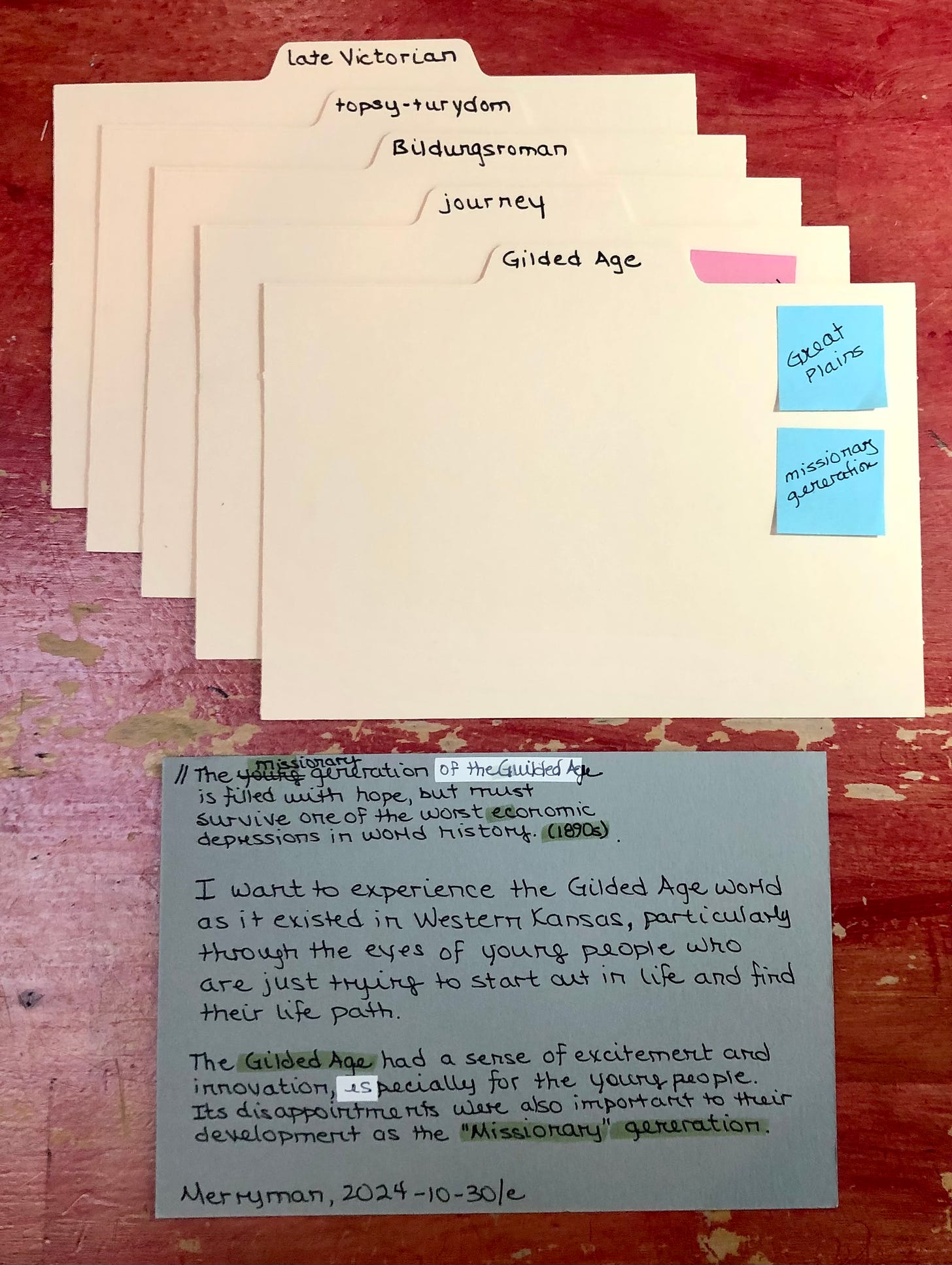Zettelkasten: Numbering, Directory Card, Indexing
Ah, I think I see the value of the Foundation Card concept.
This week it all starts to come together.
Kathleen Spracklen’s Minimalist Zettelkasten Course (YouTube)
Okay … got my Cores from last session.
Now, going through my “Foundation” Cards.
I have multiple subjects per card, so I’m going to think carefully about which Subjects make the most sense and then which Core is the best home.
The chosen Subject is written on a sticky note and put on the Core divider. As you can see, it’s not always a one-to-one relationship: In many instances, there are Foundation Cards that could go under different Cores and Subjects.
In the example above, I want this card to fall under Core: Bildungsroman because that’s the type of thought stream I want associated with it. But there really wasn’t a word that I felt that connected it within the wording of the card. So I added “Healing” as a Core Subject because that’s the first thing that popped into my mind. I don’t know why this somehow resonates, but I’m going with my intuition on this one.
In the example above, I want to create to backfill a sort of hierarchy to create a context around the Core Subject of “threshing.” So I added additional Core Subjects that aren’t called out in the Main Card because they’re “understood” in “thresherman culture.”
Okay, Core Subjects identified from the “Foundation” Cards content.
Did a little rearranging of the order and consolidated narcissist and empath because the whole point is the conflict between them.
Now I have a problem.
My cards have multiple topics. If I use a card as a Foundation Card for one Core Subject, then what will happen if there are additional Core Subjects that gets left out of its associated Core?
That didn’t actually happen in this case because whenever I ran into cards that applied to different Cores, I always had another card for that Core Subject. But it makes sense that it could happen in the future.
I think to be a true Foundation Card, it’s important that the content reflect only one self-contained, targeted idea that can support a Directory Card “conversation” around that central idea.
To make sure the Foundation Card and the Directory Card work together to continue a targeted conversation, I’m going to create another layer between the Core Subject and what was a Foundation Card, but now is just a regular, old Main Card.
I guess I could still think of these cards as “Foundation” only in that they informed the creation of the Core Subjects. I’m still trying to get my head wrapped around this, but it seems to me that Spracklen’s approach has more of a top-down organization, but in my case I’m leaning toward a bottom-up or emergent understanding of what my topic are. In this case the card can be just a regular old Main card, but it backfills its genealogy of Foundation/Directory ~> Subject ~> Core.
This new Foundation Card exists as a “bridge” that clearly connects the original “Foundation”/now Main Card that inspired the whole thinking process that led to the Core Subject.
Then that card can have the number/letter identifier which can have a Directory card behind it with the same number. I’ll word this new Foundation Card so that it clearly identifies only ONE subject or idea like Spracklen’s do. Then the Main (previously Foundation) cards can be a part of the conversation on the Directory Card.
The middle row indicated by the pen are these new Foundation cards that contain one single idea that can be the Directory Card platform.
Example above:
(1) Protagonist’s Journey
(A) narcissist vs empath
(1A) Merryman explores the conflict between a narcissist and an empath.
(1A) Directory includes:
(1A.1) In Merryman, the antagonist is a vulnerable (covert) narcissist who uses manipulation to achieve her goals.
(B) humanity
(1B) Merryman tracks a journey back to one’s unique humanity.
(1B) Directory includes:
(1B.1) To create a comforting, engaging, healing, “familiar", storyworld, Merryman’s construction is serial, short story, episodic narrative.
(1B.2) Although Merryman references historical people and events, the main goal will be to create a person story with humanity.
(C) relationships
(1C) Merryman addresses the relationships unique to the formative years. (reworded since the above photo was taken)
No Main Cards at this time. The card that could have gone here will go in Topsy Turvy ~> Jack Point.
(3) Topsy-Turvydom
(A) Jack Point
(3A) Jack Point is the most important “reference” for the events/themes happening in Merryman.
(3A.1) The protagonist in Merryman experiences complicated relationships with the women in his life which in some way matches Jack Point + Elsie Maynard’s relationship in The Yeomen of the Guard.
Whew!
Okay now on to indexing … which is, yes, very true, incredibly relaxing and reassuring in a “copywork” kind of vibe ….



















